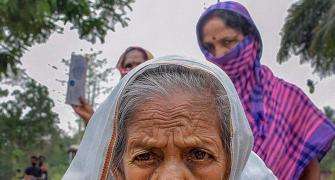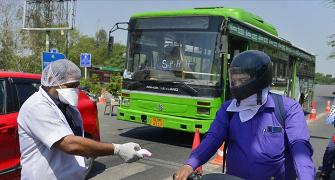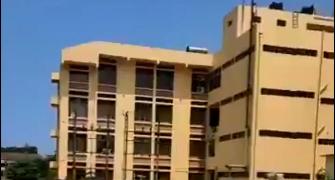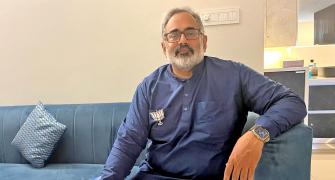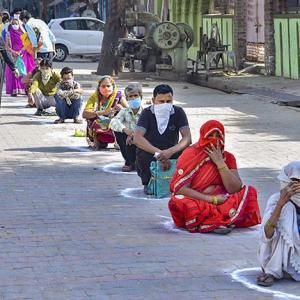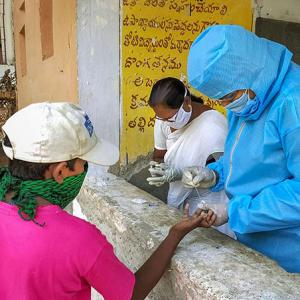'In the absence of a vaccine, as long as there are pockets of active cases in India, it would be good to have a limited lockdown.'

Professor Sitabhra Sinha of the Institute of Mathematical Sciences, Chennai, has conducted a statistical analysis of active COVID-19 cases in India, which reveals a significant drop in the growth rate of the spread of the pandemic in the country.
Professor Sinha attributes the decline majorly to the national lockdown and physical distancing.
The growth rate of the disease is determined by the value of a reproduction number denoted by R0. It indicates the mean number of people that will be infected by one COVID-19 patient till the latter remains infected.
The value of R0 calculated by Professor Sinha during the study was 1.83 from March 4 to April 6. However, from April 6, it registered a drop to 1.53.
The drop is significant, says the professor, adding that "based on data from April 13-18, we see a further decrease in the rate of growth of the disease".
"It is possible that there could be other factors responsible for the slowing down. However, I have reasons to believe the lockdown is the dominant causative factor," Professor Sinha told Rediff.com's Utkarsh Mishra.
Please tell us more about your study. How you conducted it and what are some of the key findings.
We have been monitoring the number of active cases of COVID-19 in different parts of the world starting from March 11.
Initially, our focus was on China and European countries as the number in India was too few to do any meaningful statistical analysis.
However, we made our first India analysis and near-term projection on March 18, and from then on have been regularly updating this with new data.
We used the data put out by the World Health Organisation and made available by the Center for Systems Science and Engineering, Johns Hopkins University, at github.com (external link).
Once the number of cases in the individual states crossed a couple of hundreds, we started doing our analysis at state-level also, using data from the ministry of health and family welfare.
Our main focus was to estimate the rate of growth of the number of active cases in the different regions, and use this to give short-term projections.
The key findings, in short, are:
i. The initial growth rate of the disease in India corresponds to a basic reproduction number, R0 of 1.83 +/- 0.03 (reproduction number is the average number of people who get infected by a single infected person over the period in which the latter remains infected); and this value is actually on the lower side of the spectrum (the values of R0 range from 1.5 to just less than 4) that we have estimated from regions around the world where there have been large outbreaks;
ii. Following the imposition of lockdown on March 24, the growth continued to follow the trend which we had observed from March 4 (when the number of cases in India first jumped to double digits) until starting April 6 (when) we noticed the beginning of a systematic deviation which eventually turned out to signal a reduced growth rate of the number of active cases -- this corresponded to an effective reproduction number, R0 of 1.53 +/- 0.03 (this has reduced further recently, as shown in the graph below, red line shows predicted the number of cases using initial figures while blue line shows actual number of cases in the lockdown period);

iii. When we look at the individual states it's a very complex situation with some states -- Kerala and Tamil Nadu -- showing linear trend suggesting that the epidemic has been contained, while others like Maharashtra are showing exponential growth (although over the last 3-4 days there are signs that the growth is finally slowing, as shown in the graph below).

Is the overall drop that you noticed in R0 significant? Does it suggest that we may see a drop in the rate at which new cases are being reported in the coming days?
Yes, the difference between 1.83 +/- 0.03 and 1.53 +/- 0.03 is certainly statistically significant.
One will better understand the importance on realising that had the original growth rate continued, we would have had 35,000 active cases by April 20, and about 1 lakh active cases by April 27.
By contrast, the growth rate estimated from the data of April 6 to 12 suggests that typically we should have had about 18,000 active cases by April 20.
An important point to add is that, based on data from April 13 to 18, we see a further decrease in the rate of growth of the disease.
The effective reproduction rate (R0) is now 1.36 +/- 0.04.
At this slower rate of growth, we should have about 25,000 cases by April 27 (instead of the 1 lakh cases going along the original rate of growth, or 37,000 if we had continued along the rate we estimated from April 6 to 12).
However, the slowing of the growth rate does not mean that we would see the actual number of cases reducing -- it's just that the rate at which it was growing will reduce.
Unless R0 becomes less than 1, the actual numbers will keep increasing, albeit slowly.
What other factors may account for this drop, apart from the lockdown?
Some experts believed that the spread would slow down at higher temperatures, did you take such factors into account?
It is, of course, possible that there could be other factors responsible for the slowing down.
However, there are two reasons that I believe the lockdown is the dominant causative factor:
i. The time of onset of the slower rate of growth matches out the expectation that the effect of lockdown, if it was discernible, would be visible about two weeks after its beginning on March 24.
This is because it takes up to two weeks for a person infected with COVID-19 to show symptoms.
So, most of the cases that were reported up to April 6 could be attributed to infections which happened before the lockdown.
ii. We have done a correlation analysis of the basic reproduction number of various regions around the world and the mean temperature for those places at the relevant period, and there seems to be no statistically significant correlation (of course, it is possible that there is a critical value above which the temperature must rise to have any effect on the pathogen, and that the places we used for our analysis never reached such high temperature).
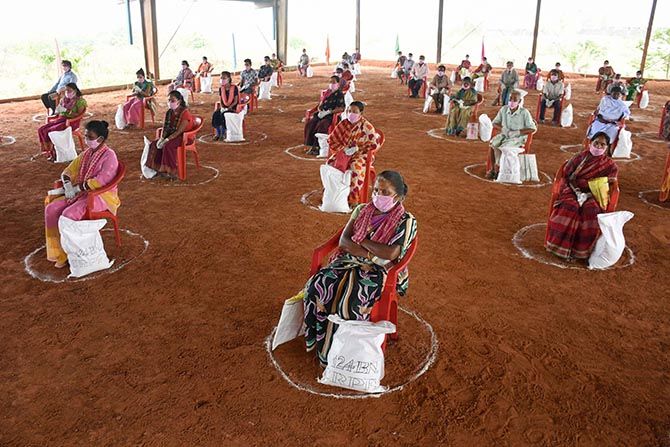
In the first two weeks of the lockdown, the country saw an approximate increase of 4,780 cases.
While in the last week itself, there was an approximate increase of 5,500 cases.
What does it say about the effectiveness of the lockdown?
Can the increase be merely attributed to more testing?
The actual number of cases is not a very good measure as it depends on what is the number of cases you are starting from.
You should rather look at the rate of growth and that has definitely reduced as is clear from the figures attached.
The study suggests that there is a linear growth of spread in Kerala and Tamil Nadu, as opposed to exponential growth in the rest of the country.
Have you calculated the country's average R0 without taking into account data from these two states?
If yes, what does it suggest about the effects of the lockdown in the rest of India?
I have not calculated the national R0 by first calculating the R0 for the different states and then averaging over these values, but rather from the trend of the all-India time-series of number of active cases obtained from World Health Organisaiton.
Most of the states have so few active cases that one cannot do any robust estimation of R0 from the data.
Only the top 10 states have enough number of cases to make estimation of RO a meaningful exercise.
Many experts say Kerala has managed to tame the spread of the virus due to its better healthcare system and massive contact tracing. Did you consider these factors?
My analysis only looks at the trend. We do not have a causative explanation as to why Kerala did better -- although as the linear growth rate is there throughout the period, it suggests that it had always been contained right from the start.
In contrast, Tamil Nadu started at a very slow linear growth rate, which in March 30 increased suddenly to a high growth rate (although still remaining linear).
In the case of states like Gujarat that have seen a steep rise in the number of cases since April 8, can it be said that lockdown was ineffective or they went wrong somewhere else?
A similar question about Maharashtra, which, your study suggests, doesn't show any signs of a reduced rate of growth?
Maharashtra has just started showing a drop in rate of growth of the number of active cases.
From the analysis we cannot really conclude as to the causative factors.

Have you compared the graph of COVID-19 spread in India to countries where there has been no lockdown?
If you can suggest a country which has had a large number of cases but no lockdown, I can get back to you with the comparison.
As per your study, in case of no lockdown or a delayed one, what could have been the number of cases today?
Do you agree with the proposal that the lockdown in some form should be there until a vaccine is found?
I already mentioned in my answer to a question earlier that without a lockdown, we would probably have had close to 35,000 active cases by April 20 (assuming that the growth continued in its original rate).
Yes, I do agree that in the absence of a vaccine, as long as there are pockets of active cases in India, it would be good to have a limited lockdown.

